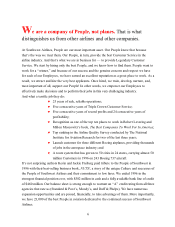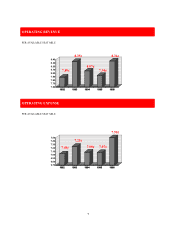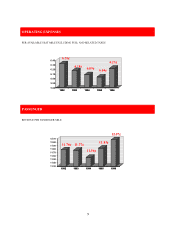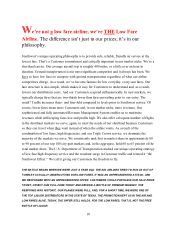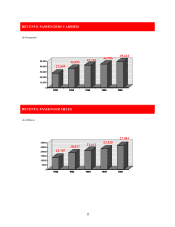Southwest Airlines 1996 Annual Report Download - page 12
Download and view the complete annual report
Please find page 12 of the 1996 Southwest Airlines annual report below. You can navigate through the pages in the report by either clicking on the pages listed below, or by using the keyword search tool below to find specific information within the annual report.12
We didn’t invent productivity, we just perfected it. If
there’s a faster, better way to do something, we’ll find it.
Productivity and the Spirit of our People have always been our secrets to low costs. Southwest
has been able to continually achieve the highest productivity and, therefore, the lowest costs of
any U.S. airline. One of the primary reasons for our productivity advantage is our dedication to
the low-fare, point-to-point market niche. This market focus allows us to operate a single aircraft
type, the Boeing 737, which significantly simplifies scheduling, operations, and maintenance and,
thus, minimizes costs. We schedule our 737s on a point-to-point basis, as opposed to hub-and-
spoke, and concentrate on nonstop, not connecting traffic. Inflight services are also designed and
streamlined to meet the needs of primarily shorthaul passengers. As a result of this strategy, our
People have the ability to turn aircraft much quicker than our competition allowing us to
minimize ground time. In 1996, we kept our planes in the air eleven hours and seven minutes on
average per day, which is significantly more than our competition. This statistic is even more
remarkable when you consider that our average flight lasts just over an hour. We also understand
that delays are very costly in terms of Customer satisfaction, aircraft utilization, and, ultimately,
the bottom line. Our young, well-maintained fleet results in an excellent reliability record. In
1996, less than one percent of our flights were canceled due to mechanical incidents, which
improves our productivity and contributes to lower operating costs. Our operating approach also
allowed us to handle approximately 2,300 Customers per Employee in 1996, making our People
by far the most productive workforce in the industry. Even though our Employees’ compensation
is above industry averages, we achieve competitive unit labor costs because of our People’s
dedication, extra effort, and remarkable productivity.
OH, THE STORIES WE COULD TELL. BACK WHEN WE BEGAN, A QUARTER OF A CENTURY AGO, WE
HAD LESS THAN NOTHING. NO COMPUTERS. NO TICKETING MACHINES. NO FANCY OFFICES. JUST
THREE PLANES, A HANDFUL OF DEDICATED EMPLOYEES, AND THE CONVICTION THAT ABSOLUTELY
NOTHING COULD STOP US. AND NOTHING HAS. TODAY WE’RE INNOVATORS IN TICKETLESS TRAVEL,
PIONEERS ON THE WORLD WIDE WEB, AND EVERYONE ELSE IS TRYING TO COPY OUR LOW FARE
APPROACH. NOT BAD FOR AN AIRLINE THAT HAD TO COUNT CUSTOMERS BY HAND AND TAKE
RESERVATIONS FROM A SINGLE ROTARY PHONE.






